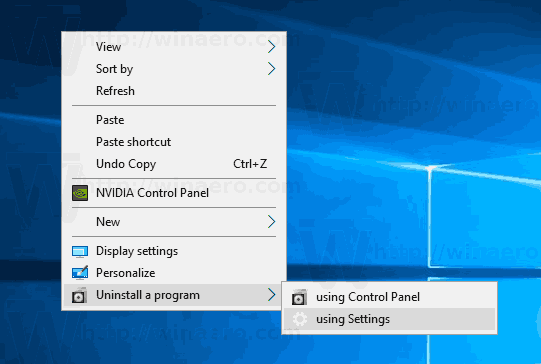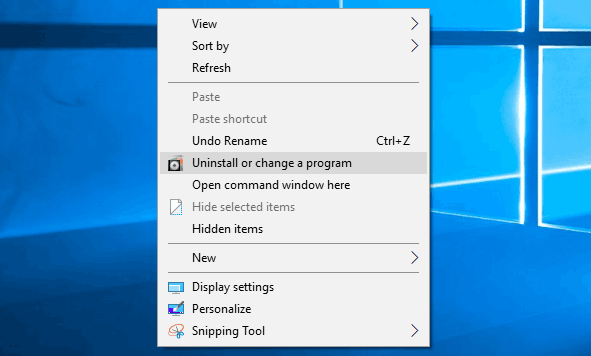Windows 10 supports two types of apps: classic Desktop apps (Win32) and modern Store apps. A classic app can be installed for all user accounts available in the OS. A Store app will be installed to each user account separately. If you no longer use some app, it is a good idea to uninstall it and free up space on the drive.
Advertisеment
Windows 10 comes with two tools you can use for uninstalling apps. These include the classic Control Panel applet, "Uninstall a program", and the "Apps & features" page in Settings.
For your convenience, you can add a special context menu Uninstall a program to the Desktop context menu. It will save your time, especially if you are installing and removing apps frequently.
After following the steps below, you'll get the following context menu:

To add Uninstall a Program cascading context menu in Windows 10, do the following.
- Download these Registry files: Download Registry Files.
- Unblock the downloaded files if required.
- Extract them to any folder you want, e.g. you can extract them to your Desktop folder.

- Double-click on the file Add Uninstall a Program context menu.reg to import the tweak.
- Confirm the UAC prompt and you are done.
The undo tweak is included, so you can quickly remove the context menu you added at any moment.
The Registry tweak adds both Settings and the Control Panel options to the context menu, so you will be able to quickly open the preferable tool to uninstall an app.
How it works
The context menu uses the following command to open the appropriate page of the Settings app:
explorer.exe ms-settings:appsfeatures
In Windows 10, there is a set of such ms-settings commands which you can use to open almost any page of the Settings app directly. Earlier, I covered them in the following article:
ms-settings Commands in Windows 10 Fall Creators Update
The classic Control Panel applet can be opened with the following command:
control.exe /name Microsoft.ProgramsAndFeatures
Starting in Windows Vista, Microsoft added the ability to open different pages of the modern Control Panel pages. The control.exe file, which is the main executable file of the Control Panel, supports two special options, /NAME and /PAGE. The /NAME option opens an applet or a wizard directly.
You can find the list of Control Panel commands available in Windows 10 in the following article:
Open Control Panel Applets Directly in Windows 10
Alternatively, you might want to add a single command to the context menu. The article "Add Uninstall a Program Context Menu in Windows 10" explains how to add the following context menu to the Desktop:
It opens the Apps and features page of the Settings app directly by adding a special Ribbon command to the Desktop context menu.
That's it.
Related articles:
- How to Uninstall Apps in Windows 10
- How to Create Windows Update Shortcut in Windows 10
- Add Settings Context Menu In Windows 10
- Create Shortcut to Open Any Settings Page in Windows 10
Support us
Winaero greatly relies on your support. You can help the site keep bringing you interesting and useful content and software by using these options:

Hello Sergey,
Thanks for all the Windows help.
Do you have an article on how to get a window that seems to be stuck off to the side to show on the main screen.
I can see the window when I click on the icon on the taskbar, but I can not get it over to the screen.
I have tried the move command, but no luck.
Please steer me to a link if you have one that explains how to fix the issue.
Have a great day,
Jim Miller
Hello Jim,
Please refer to the article How to Move Off-Screen Window Back To Screen in Windows 10
Thank you!
Good one Sergey! Thank you. Been a while since winaero was updated. :)
yeah… I am running out of time.